|
DOWNTOWN
POST NYC
News and Events
in Lower Manhattan
|
|
|
|
Volume 1, No. 101 Aug. 6, 2014
|
Quote of the day:
"My uncle worked in a restaurant. My grandmother scrubbed floors. But they were living quite comfortably here." - Joe Svehlak, describing immigrant life on the Lower West Side at the turn of the last century.
* In search of the immigrant Lower West Side * New York State attorney general's tips for Internet and identity security * Bits & Bytes: BPCA's geothermal wells; Meal deals; Howard Hughes exec writes to The Times * Block printing workshop at Bowne Printers in the Seaport * Letter to the editor: Calatrava transit hub displeases * River & Blues festival wraps up with Sun Ra Arkestra * Calendar
Wagner Park in Battery Park City. July 31, 2014. (Photo: Terese Loeb Kreuzer)
|
|
|
|

|
IN SEARCH OF THE IMMIGRANT LOWER WEST SIDE
 | Joe Svehlak, whose family lived on the Lower West Side when the neighborhood was known as "Little Syria," leading a walking tour of the area.
(Photos: Terese Loeb Kreuzer)
|
The Lower West Side, said Joe Svehlak, a licensed New York City tour guide, was once the most diverse immigrant neighborhood in New York City. Where high-rise hotels and office buildings now proliferate, an estimated 10,000 people crowded into the narrow streets between Battery Park and the World Trade Center site, and between West Street, then bordering the Hudson River, and Broadway. In the early 1900's, Svehlak's mother and her family were among them. They were Slavic, brought to this country by Svehlak's grandmother, who came first and then sent for her husband and four children. They joined a neighborhood made up Lebanese, Syrians, Armenians, Greeks and Turks and others displaced by the break-up of the Ottoman Empire. They had been preceded by Irish and Germans, who had settled in the neighborhood in the 1840s. There were 27 nationalities in all, within about one square mile. "It was a great American story of integration," said Svehlak, "unique to the Lower West Side." Svehlak poured out this story, both personal and historical, on a walking tour on July 27. It was organized by the Friends of the Lower West Side as part of its campaign to preserve the remnants of what was once known as "Little Syria" because so many Syrians had settled there. Svehlak said that it was "The mother colony of all Arabic settlements in the United States." Not much is left, done in twice by the City's exercise of eminent domain. In the 1940s, Robert Moses condemned many of the tenements on the lower parts of Greenwich and Washington Streets in order to build the Brooklyn Battery Tunnel. At that time, some members of the community fled to Brooklyn. Others moved north, only to be displaced again around 20 years later by clearances for the World Trade Center. 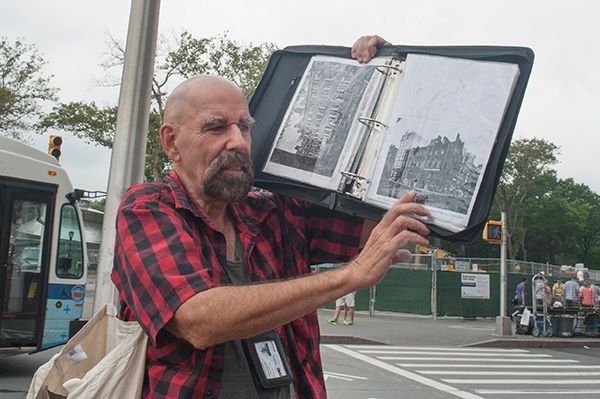 Svehlak constructed his account of this all-but-lost world mostly with photographs and ephemera such as the subway sign that says "South Ferry" - a reference to the time when a ferry connected Lower Manhattan with Brooklyn, where some members of the "South Ferry community" moved in the 1890s. "In the 1940s, my mother walked me around the neighborhood," Svehlak, now 74 years old, recalled. "I returned to it from 1956 to 1958 to work as a messenger." Much of what he saw then has disappeared in his lifetime. Svehlak's mother remembered that the Lower West Side once abounded in wonderful pastry and candy shops and shops selling silks, linens and embroidery. "A Syrian lady would come to my mother's house with a big tablecloth on her back full of things she was trying to sell," Svehlak recounted. Like their neighbors, Svehlak's mother and her family lived in a tenement. "My uncle worked in a restaurant, " said Svehlak. "My grandmother scrubbed floors. But they were living quite comfortably here. They didn't want to leave. They were used to living in tight quarters. They had the Washington Market nearby and a park. They could walk to work. They felt safe."  | |
Washington Street
|
Interspersed among the office buildings, there are a few tenements left, and on Washington Street, three neighboring buildings from the Lower West Side's immigrant heyday. A tenement at 109 Washington St. was once home to Svehlak's mother and her family. It is around 130 years old, and perhaps older, built in a restrained style with cast iron window frames and ornamental swags over the windows. Next to it is a community house that opened in 1926 to serve the health, educational and social needs of the neighborhood. It was largely constructed with funds donated by William H. Childs, the founder of the Bon Ami household cleanser company. It contained the first public library in downtown Manhattan plus clinics, a milk dispensary, an assembly hall, a cooking school, a gymnasium and a nursery. For several years, it has been empty with a sign in front that says that it's for lease. At one point, it was slated for demolition. Next to that is the former St. George's Melkite Church, now a restaurant. "Ninety percent of the Arabs in this community were Christian," Svehlak remarked. The former church is the only one of the three Washington Street buildings that is landmarked, although the Friends of the Lower West Side have tried repeatedly to have the other two buildings landmarked as well. "Where else in New York do you have three buildings that represent three different aspects of a neighborhood existing side by side?" Svehlak asked. The Landmarks Preservation Commission claims that the buildings are not architecturally significant but the Friends of the Lower West Side have not given up. Neither did their ancestors, who came to New York with little or nothing and made it their home. - Terese Loeb Kreuzer
For more information about "Little Syria" and about the efforts to preserve the Washington Street buildings, click here. 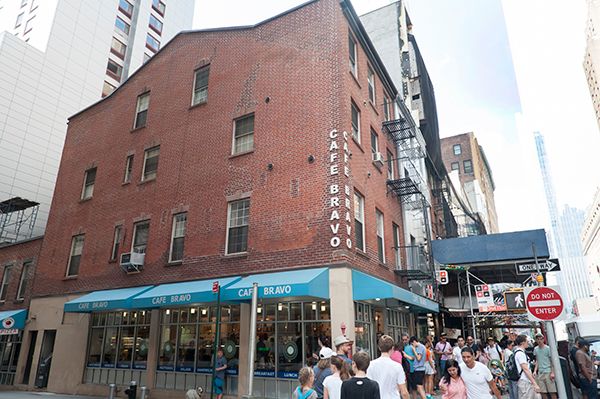 | |
A corner of "Little Syria." The house at 94 Greenwich St. (at Rector Street) dates from 1799 and is landmarked. When this house was built, this was one of the most prestigious places in New York City in which to live. When the wealthy moved uptown, the immigrants moved in.
|
|

The Paris Cafe | 119 South Street | 212.240.9797 | thepariscafeNYC.com | @theparisnyc
|
NYS ATTORNEY GENERAL SCHNEIDERMAN'S TIPS FOR DATA SECURITY
"Russian hackers amass over a billion Internet passwords" said an article in The New York Times on Aug. 5. Following this reported online security breach, New York State Attorney General Eric Schneiderman offered tips to consumers for safeguarding sensitive personal information online. This latest breach, perhaps the largest ever of its kind, targeted websites of both large and small companies as well as individuals. It is believed that individuals suspected of being responsible for such breaches sell stolen data to third parties on the black market and use the information to send spam advertisements to consumers. To read the Attorney General's advice on what to do if you have been a victim of identity theft and how to avoid identity theft, click here.
|
Bits & Bytes
BPCA'S $5M GEOTHERMAL WELLS; P.J. CLARKE'S OFFERS MEAL DEALS;
HOWARD HUGHES EXEC'S NEW YORK TIMES 'LETTER TO THE EDITOR'
 | | Meal deals at P.J. Clarke's in Battery Park City. (Photo: Terese Loeb Kreuzer) |
Battery Park City Authority's geothermal wells send dollars down the drain: The Battery Park City Parks Conservancy's headquarters building at 75 Battery Place, completed in 2010, was supposed to be heated and cooled by geothermal wells. Unfortunately, they didn't work. On July 31, the BPCA board of directors approved an expenditure of $2.956 million to Tomco Mechanical Corp. to try to fix the problem by creating a different kind of heating and cooling system.
BPCA chairman Dennis Mehiel was not pleased. He wanted to know how much had been spent on the original wells. Gwen Dawson, senior vice president of asset management, who handles construction projects, said "the net financial impact" was between $3 and $4 million, paid to Crescent Contracting. Actually, by the time change orders had been approved in an attempt to fix the non-functioning wells, it turns out that the BPCA had paid Crescent Contracting $5.174 million.
At the time of the board meeting, thinking that the BPCA was out around $3 million, Mehiel wanted to know how this had happened. "The decision was made" to skip drilling a test well, Dawson said.
"The decision was made by whom?" Mehiel persisted.
Dawson said that "due to developer time exigencies and sequencing challenges," a test well was not drilled. Following the completion of the base building and the subsequent drilling of the two system wells, modifications and enhancements were attempted in an effort to allow the system to operate within the required parameters - but without success.
Mehiel wondered whether legal steps could be taken to recover some of the money that went down the drain. Dawson said that the BPCA's legal department had recommended against a lawsuit because of the cost of litigation.
Since the Battery Park City Parks Conservancy needs an adequate heating and cooling system, there was no alternative for the BPCA board but to approve the expenditure of almost $3 million that hopefully will provide it.
As a footnote to this episode, AKF Engineering was sub-consultant to the project architect for the geothermal wells and was also one of two mechanical, electrical and plumbing engineering firms hired to work on Pier A, now nearing completion as a restaurant and visitor center at the southern end of Battery Park City. - Terese Loeb Kreuzer
Construction meal deals: P.J. Clarke's, with a prime location facing North Cove Marina on the Battery Park City waterfront, claims that its landlord, Brookfield Office Properties, is trying to force the restaurant out in order to install a ritzier, more lucrative tenant. P.J. Clarke's has sued Brookfield for $40 million and has also launched a campaign to get customers to petition Brookfield to allow P.J. Clarke's to stay right where it is. In the meantime, PJC is offering dining deals to lure customers past the scaffolding that currently blocks the restaurant's once-stunning views of the Hudson River and the Statue of Liberty. The "Construction Combo," available weekdays from noon to 4 p.m. for $11 includes a choice of cheeseburger, beef taco or a "New York Standard Foot Long" plus homemade mint lemon-limeade. From 5 p.m. to closing, customers can buy a "Renovation Rebate" with 2 for 1 draught beers and half-price oysters and clams on the half-shell. The sign outside the restaurant advertising the deals concludes with "Keep Clarke's in Battery Park" followed by "Please excuse Brookfield Place. We apologize for the construction."
A different vision for the Seaport: In response to the Op-Ed article entitled " The War on New York's Waterfront" written by Roland Lewis, Paul Greenberg and Joan K. Davidson in The New York Times (7/31/14), Philip St. Pierre, the senior general manager for The Howard Hughes
 | |
"...eating at great restaurants"...in the South Street Seaport.
|
Corporation in the Seaport wrote a letter to The Times that appeared under the heading "Revitalizing the South Street Seaport" (New York Times, 8/5/14). In the letter, he says that the Lewis, Greenberg, Davidson Op-Ed "does not reflect what is really happening at the South Street Seaport and our vision for the future. A trip to this special part of New York reveals something we haven't seen for decades - New Yorkers enjoying the waterfront and the historic district, eating at great restaurants, enjoying culture, admiring the tall ships. In the aftermath of Hurricane Sandy, we have brought energy back to the Seaport to return the district to normalcy. Next is the complete
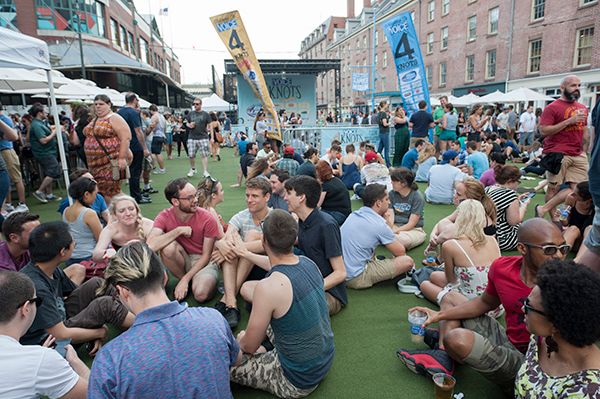 | | "...enjoying culture"...in the South Street Seaport. |
transformation of Pier 17, a world-class shopping and dining destination that will offer breathtaking open space, including a rooftop performance venue." St. Pierre refers to The Howard Hughes Corporation as "stewards of this iconic destination" and says that HHC's "vision includes restoring the historic Tin Building, finishing the East River Esplanade, and rebuilding an active waterfront with a new marina, revitalized museum and world-class food market." For the complete letter, click here.
|
BLOCK PRINTING WORKSHOP AT BOWNE PRINTERS IN SEAPORT
 | Ali Osborn, resident printer at Bowne Printers, part of the South Street Seaport Museum, watching Marisa Ohara create a print from a linoleum block at a block printing workshop.
(Photos: Terese Loeb Kreuzer)
|
Equipped with blocks of linoleum, gouging tools of varying widths, pencils, paper, and a few ideas, Ali Osborn's block-printing class settled in around a large table at Bowne Printers in the South Street Seaport. Bowne, at 211 Water St., is part of the South Street Seaport Museum and has an extensive collection of historic printing presses and antique type. Most of the time, Osborn and Gideon Finck, resident printers at Bowne since the fall of 2012, utilize this equipment to produce posters, cards and custom-made stationary. Linoleum block printing is just a small part of what they do. However, Osborn holds what he calls "Block Parties" once a month during which he teaches the basic principles of linoleum block printing. The design, he tells his students, will be reversed when printed and the parts of the block gouged away will remain uninked, leaving the uncarved parts, like hills among valleys, to take the ink and make an impression on the paper. 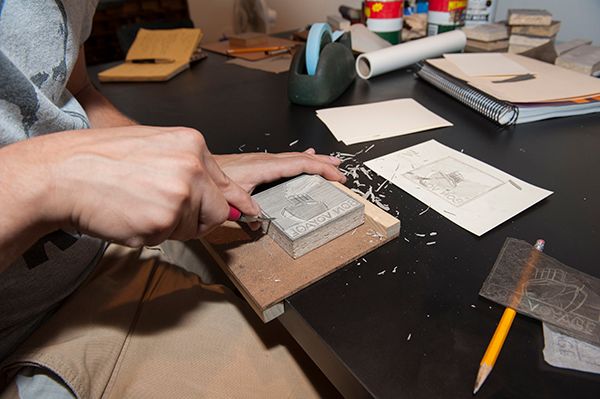 Then he shows them how to transfer a drawing to a linoleum block and how to carve into it so that the base of each incision will be wider than its summit. There is much to learn and the work is absorbing. Several hours pass quickly. When it's time to print, Osborn brings out pots of ink, rollers and rice paper to show the class how to make images manually before taking everyone's block and locking it up on the Vandercook Press, one of many printing presses in the museum's collection. Then the block-printing students take turns rolling the heavy levers of the press to produce a composite of everyone's work. Raul Barquet, 24, a gallery assistant at the Jonathan Levine Gallery in Chelsea, said that he had tried linoleum block printing on his own but had learned a lot from Osborn. "There's a lot of information on the Internet," he said, "but it's not like getting first-hand instruction." Marisa Ohara, 26, an operations and administrative associate at the South Street Seaport Museum, said that she had learned about positive and negative space and that "the more detail there is in the image, the harder it is to make a print." Osborn helped her to simplify her original design into something that she still liked but was easier to create. Said a third member of the class, "I learned how much fun this is!" The next block printing workshop takes place on Sunday, Aug. 10 from 2 p.m. to 5 p.m. Because of the tools used, the workshop is suitable for people 12 and older. Reservations are required with a non-refundable $15 deposit for materials. The cost for the workshop is $50; $40 (for South Street Seaport Museum members). For more information, call (646)-628-2707 or email b owneprinters@seany.org. To buy tickets, click here. - Terese Loeb Kreuzer
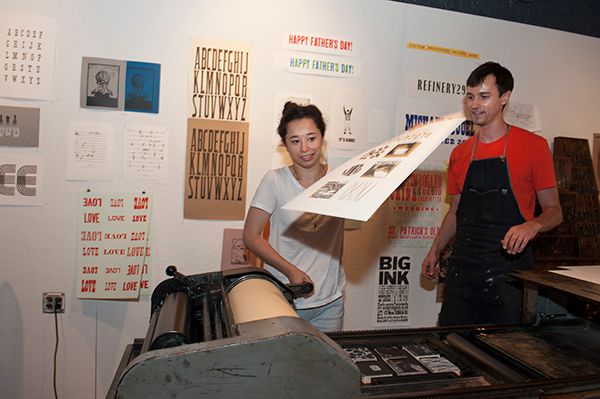 | |
Printing on the Vandercook press.
|
|

|
|
Letter to the editor
CALATRAVA TRANSIT HUB DISPLEASES
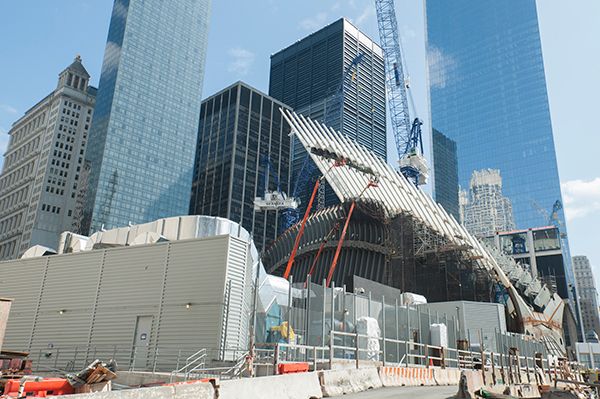
| The World Trade Center transportation hub, designed by Santiago Calatrava, is under construction and scheduled to open in 2015. (Photo: Terese Loeb Kreuzer) |
To the editor:
(Re: Bits & Bytes: "New York's $4B shrine to government waste and idiocy," New York Post, 8/2/14): I totally agree with your publication's excerpt from Steve Cuozzo's review in the New York Post conveying his response to the design of the new entrance to the PATH station at the World Trade Center's gargantuan transportation hub. What is amazingly worse, although not yet open to the public but visible from the doorway portals, is the Fulton Street entrance anchor of the hub. The touted Oculus that is supposed to provide light to the interior lobby area is massively intrusive to the entrance space, which should be at least neutrally airy. The Oculus makes the space feel oppressive and claustrophobic no matter what light it may give to the lower levels. It appears to be the result of the architect's waking inspirational dream that really was an aesthetic nightmare. How it ever got through any credentialed, sophisticated approvals defies reality.
Sy Schleimer
From the editor:
We welcome letters to the editor. Email them to editor@downtownpostnyc.com. We reserve the right to edit them for clarity and length.
|

|
RIVER & BLUES FESTIVAL WRAPS UP WITH SUN RA ARKESTRA
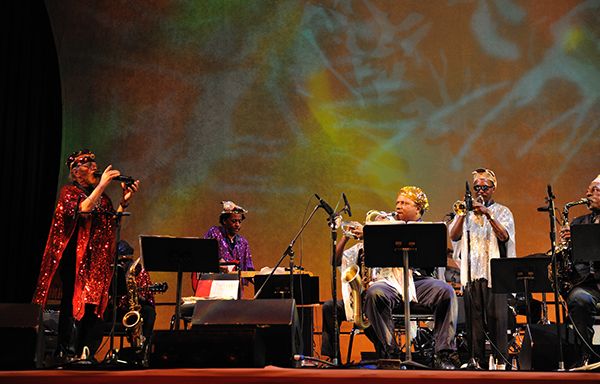 | The Sun Ra Arkestra played at the Bang on a Can marathon in Battery Park City in 2011. It returns on Aug. 7 to play in Wagner Park. (Photo: Terese Loeb Kreuzer)
|
Herman Sonny Blount was born 100 years ago this year in Birmingham, Alabama. He wanted no part of his birth name and the racism that went with it. He called himself "Sun Ra," founding an "Arkestra" whose music drew on black vaudeville, modern dance, Egyptian cosmology, Eastern philosophy, surrealism, kitsch and the Bible. Sun Ra was a jazz composer, piano and synthesizer player, poet and philosopher as well as a bandleader. The Studio Museum in Harlem presented an art exhibition this past winter based on his influential art movement called "Afro Futurism." Two years after Sun Ra died in 1993, alto saxophonist Marshall Allen became the Arkestra's leader. Now 90 years old, he still directs the Arkestra, which will be coming to Battery Park City's Wagner Park on Aug. 7 to close out this year's River & Blues festival. "I first heard the Sun Ra Arkestra in the late 1970's and saw them perform on the Washington Mall," said Abby Ehrlich, director of park programming for the Battery Park City Parks Conservancy, the producer of the River & Blues festival. In 2012 and 2013, she saw them again in Philadelphia, their home base since 1968, and hoped to book them for River & Blues. The Akestra's Battery Park City performance occurs between performances in Spain and Finland. "Sun Ra is a unique voice of the 20th century," said Ehrlich. "If you are not familiar with his writing and fantasy alternative to racial prejudice, you will find it intriguing. Sun Ra proclaimed himself a member of the Angel race, not the human race, based on painful experiences with racism." Ehrlich said that the Arkestra's music ranges from Fletcher Henderson, swing and bebop to jazz improv. "It can sound otherworldly," she said. The concert starts at 7 p.m. in Wagner Park and is free. - Terese Loeb Kreuzer
|
|
CALENDAR: Week of Aug. 4
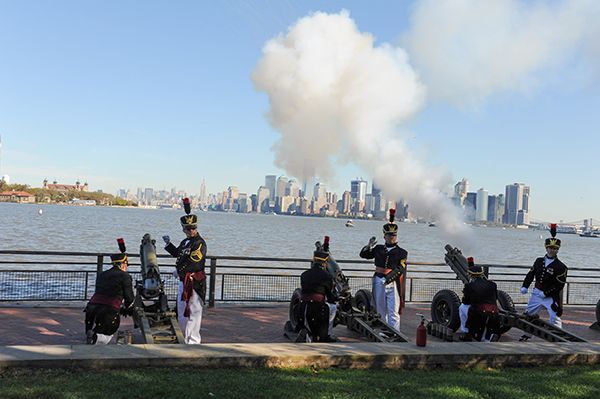 | A 21-gun salute on Liberty Island marked the 125th anniversary of the Statue of Liberty on Oct. 28, 2011. This weekend, there will be cannon firing demonstrations on Governors Island as part of a re-creation of life on the island during the Civil War. (Photo: Terese Loeb Kreuzer)
|
Aug. 7: The Sun Ra Arkestra closes out the Battery Park City Parks Conservancy's annual River & Blues festival with a concert in Wagner Park. Time: 7 p.m. Free. Aug. 8: Black Bananas and Shockwave Riderz play at the Seaport Music Festival, produced by The Howard Hughes Corporation in the South Street Seaport. According to the flyer for Black Bananas, their first album "runs the gamut from gnarly odes to reality TV to future electric metallic GoGo sounds all conceived with scraps of influence from Jennifer Herrema's childhood passions zig-zagged with other currents out there, creating a sound that will take you to a specific place that only black bananas know how to find." The Shockwave Riderz trio is described as "the meeting point between basement punk and beach-side rock with a dash of electronics for good measure." Place: Water and Fulton Streets. Time: 7 p.m.-9 p.m. Free. For more information, click here.Aug. 9: See a movie in the South Street Seaport. The Howard Hughes Corporation presents "Four Weddings and a Funeral" on the Front Row Stage. Place: Fulton and Front Streets. Time: 8 p.m. Free. For more information about this and other events in the Seaport, click here. Aug. 9: During Civil War Weekend on Governors Island, visitors will see reenactments of a typical day in the life of Union soldiers stationed on the island and their prisoners from the Confederate army. This is the 8th year that the National Park Service has invited living historians from the 119th New York Volunteer Infantry and the Liberty Rifles to come to Governors Island to help tell the story of its Civil War history. Also on Aug. 10, each day's events will begin with cannon firing demonstrations at 11:30 a.m. On Saturday, there will be a Civil War baseball game at 4 p.m. Free. For more information, click here. For information about ferry service to Governors Island from Manhattan and Brooklyn, click here. Aug. 10: Block-printing workshop at Bowne Printers, part of the South Street Seaport Museum. Students will learn the basics of linoleum block printing and how to print manually and on a printing press. Place: 211 Water St. Time: 2 p.m.-5 p.m. Because of the tools used, the workshop is suitable for people 12 and older. Reservations are required with a non-refundable $15 deposit for materials. The cost for the workshop is $50; $40 (for South Street Seaport Museum members). For more information, call (646)-628-2707 or email b owneprinters@seany.org. To buy tickets, click here. Aug. 10: Full moon sail: As the sun sets and the full moon rises, come aboard the South Street Seaport Museum's 1885 schooner, Pioneer, for a two-hour cruise of New York harbor. This month's full moon is this year's "super moon" -- the largest moon we will have for 2014. This is because on Aug. 10, the moon will be its nearest to the earth for the entire year. Bring your own food and beverages. Place: Depart from and return to Pier 16 in the South Street Seaport. Time: 7:30 p.m.-9:30 p.m. Tickets: $45 (adults); $35 (museum members); $25 (children); $10 (child under 2). To buy tickets, click here.
Aug. 10: Aboard a New York Water Taxi, Gabriel Willow, a naturalist with the New York City Audubon Society, will lead an ecocruise to Jamaica Bay. There will also be one on Aug. 17. The cruise is three hours long (6 p.m. to 9 p.m.). For more information and to buy tickets, click here.
Ongoing: The Seaport Music Festival, produced and partially sponsored by The Howard Hughes Corp., continues on Friday nights through Aug. 29. Place: Fulton Street at Water Street. Time: 7 p.m. Free. For more information, click here.
Ongoing: Every Friday through Aug. 22, join a master drummer in Battery Park City's Wagner Park for Sunset Jams on the Hudson. Improvise on African, Caribbean and Latin rhythms. Drums provided, or bring your own. Place: Wagner Park. Time: 6:30 p.m. to 8 p.m. Free. For more information, click here.
Ongoing: An exhibit in the Lower Manhattan Cultural Council's arts center on Governors Island examines a pivotal time in Trisha Brown's early career as an artist and choreographer, as well as a particularly fertile moment for artistic production in New York City. With videos, photographs and installations, "Trisha Brown: Embodied Practice and Site-Specificity" highlights Brown's community of performers and artists, and the Lower Manhattan in which they lived and created. The exhibit shows Brown's investigation of simple movements such as walking or dressing, and the built environment, specifically through performances that took place on buildings inside and out, museum walls, parks, cobblestone streets, and other non-traditional performance spaces. The exhibition also bridges the transition in Brown's practice from site- and gallery-based work to proscenium stage work, for which she became well-known throughout the 1980s and beyond. Through Sept. 28. Times: Fridays and Sundays, noon to 5 p.m. Saturdays, 10 a.m. to 5 p.m. Free. For more information, click here.
Ongoing: Poets House presents its 22nd annual showcase, a free exhibit featuring all of the new poetry books and poetry-related texts published in the United States in a single year from over 650 commercial, university, and independent presses. Through Aug. 16. Place: 10 River Terrace. Free. For more information, click here.
Ongoing: "From Drills to Drums: Civil War Life on Governors Island." A program for kids, who will see first hand the lives of soldiers, civilians and prisoners on the island in the 19th century. No tickets or reservations required, but large school or day camp groups should call (212) 825-3045. Every Wednesday, Thursday and Friday. Place: Governors Island. Time: 10:20 a.m. Also at 11:20 a.m. Free. Ongoing: Hike Through History. The most comprehensive tour of Governors Island National Monument takes in nearly every highlight in the historic district. No tickets or reservations required. Visitors should be prepared to stand for a full 90 minutes and walk a distance of about 1.5 miles. Wednesdays to Sundays. Place: Governors Island. Meet at Soissons Dock. Time: 2 p.m. For more information, click here.
Ongoing: "A Town Known as Auschwitz" is an exhibit of photographs at the Museum of Jewish Heritage tracing the history of a town called "Oswiecim" in what is now Poland, where Jews and non-Jews lived side by side for centuries. When German forces occupied the town in September 1939, they renamed it "Auschwitz" and established a concentration and death camp there. More than 1 million people died at Auschwitz, including 90 percent of the town's Jews. The museum is at 36 Battery Place. For information the exhibit, click here. For information on the museum's hours and admission fees, click here.
Ongoing: Poets House in Battery Park City presents "A Painter and His Poets," the first major retrospective show of George Schneeman's collaborative paintings, collages, prints, and books, with portraits of his poet friends, spanning 40 years. "A sort of utopia in the visual field filled with pleasure, quickness and wit" is how Schneeman himself described his collaborative work with poets. Exhibition on view through Saturday, Sept. 20, during regular Poets House hours. Place: 10 River Terrace. Free. For information about Poets House, click here.
Ongoing: The South Street Seaport Museum's lightship Ambrose and its barque Peking welcome visitors Wednesdays to Sundays, 11 a.m. to 5 p.m. on Pier 16 (on the East River at Fulton Street). The Ambrose, launched in 1908, once guided large ships through the Ambrose Channel into New York harbor. Peking was launched in Hamburg, Germany in 1911, one of the last commercial sailing ships ever built. She was used to carry goods from Europe to South America and to return to Europe with nitrate. The museum's Visitors Services associates explain all of the fascinating details of the ships and their relevance to the history of New York as a port city. Cost: $12 (adults); $8 (students, 12-24 and seniors); $5 (children 2-11); under 2, free. To buy tickets, click here.
Ongoing: "Defining Lines: Maps from the 1700s and early 1800s" at the Fraunces Tavern Museum. Twenty-seven maps provide a perspective on the evolving nation's place in history. A map from 1804, never before exhibited, shows the U.S. postal routes. Place: 54 Pearl St. Time: Noon to 5 p.m., daily. Admission fees: $7; $4 (seniors, students with ID, children, 6 to 8 years old. Children, 5 and under, free. Active military with ID, free. For more information, click here.
Ongoing: The National Museum of the American Indian is open daily from 10 a.m. to 5 p.m., with free admission. It offers free films, docent-led tours of its exhibitions and tours of its premises, the Alexander Hamilton U.S. Custom House, designed by Cass Gilbert. The building, which was completed in 1907, is a National Historic Landmark and is listed on the National Register of Historic Places. One Bowling Green. Phone: (212) 514-3700. For the museum's calendar, click here.
|
|
|
Downtown Post NYC is emailed Mondays, Wednesdays and Fridays.
Editor: Terese Loeb Kreuzer
All articles and photographs in Downtown Post NYC are copyrighted and
may not be reprinted or republished without written permission.
© 2014
|
|
|
|
|